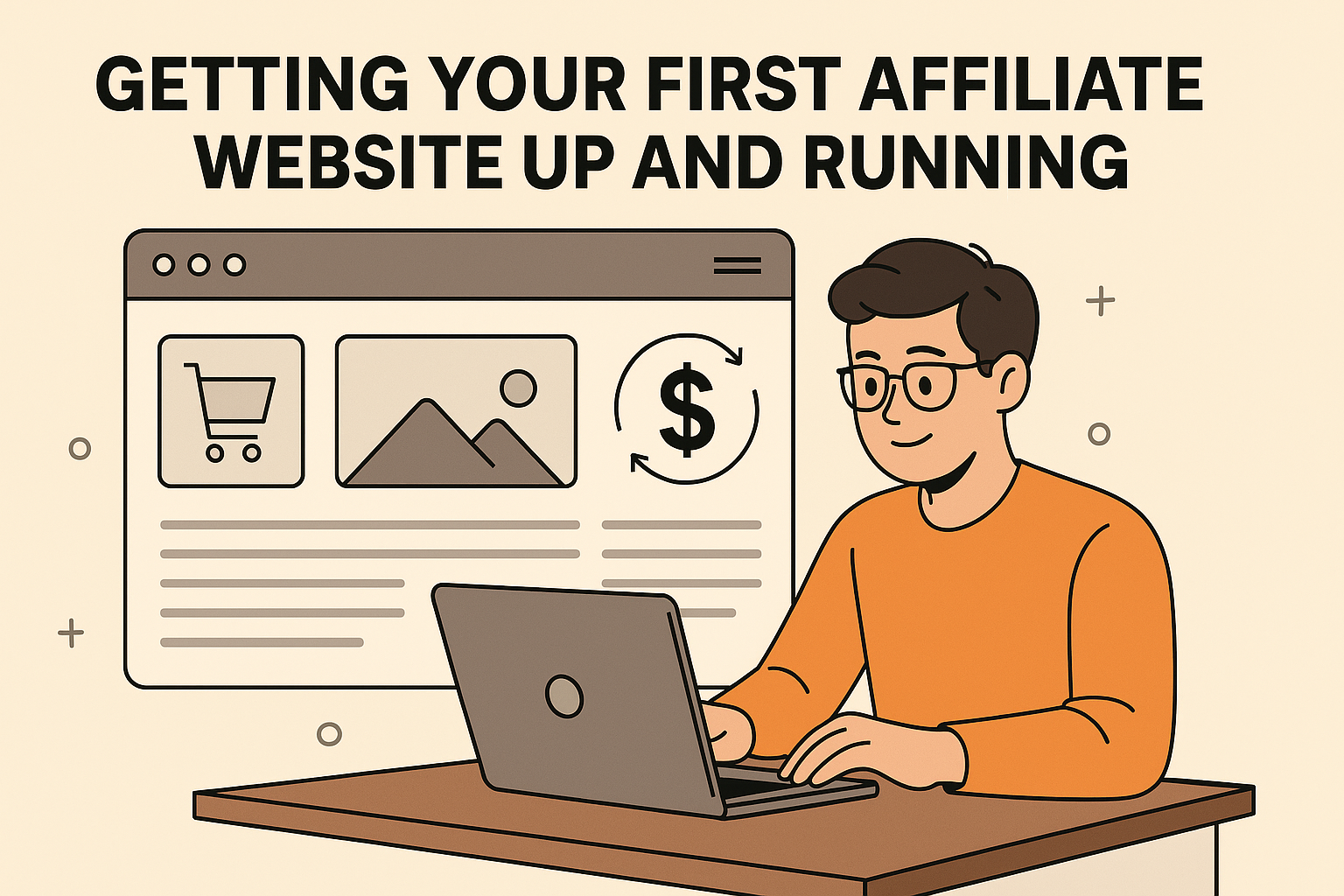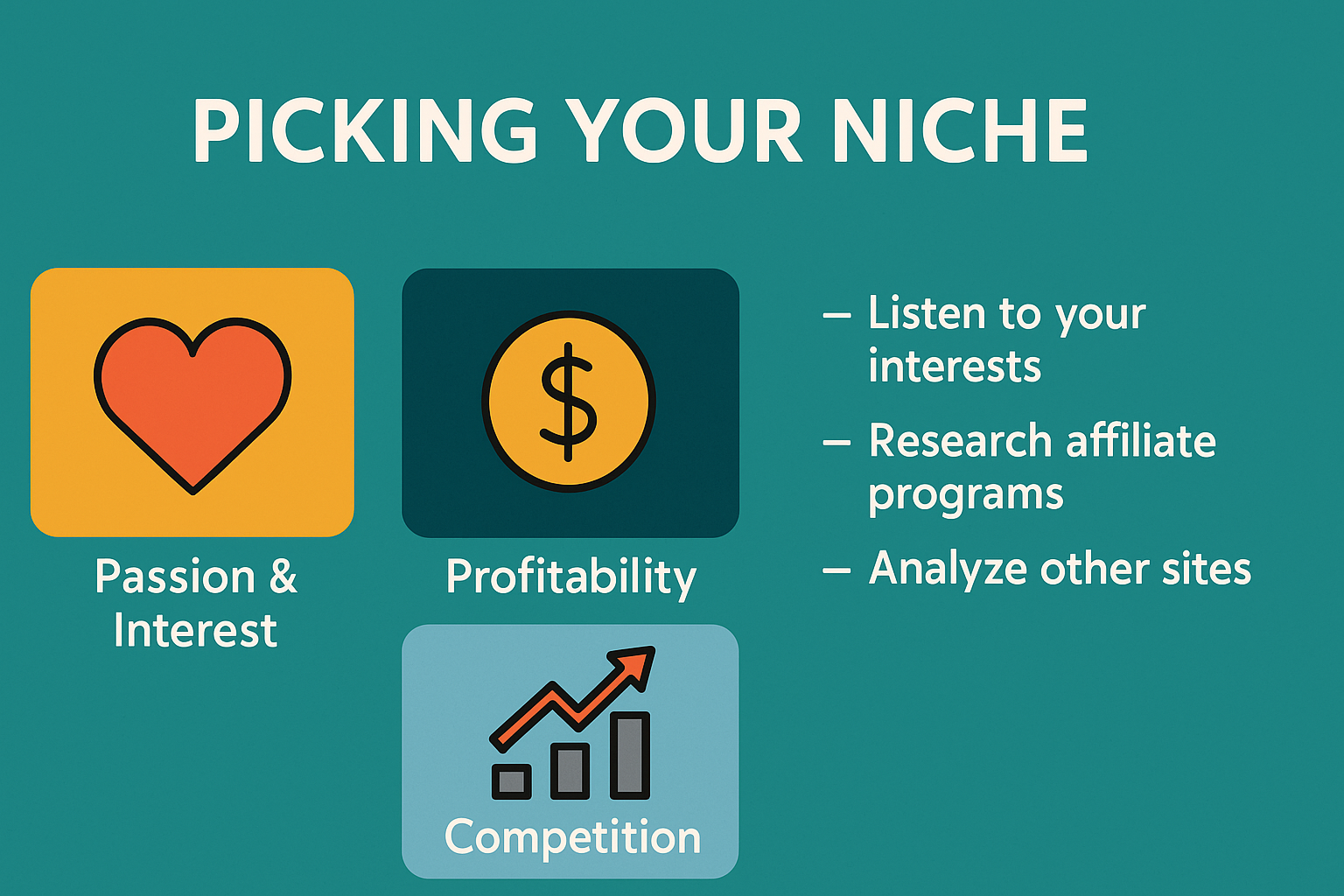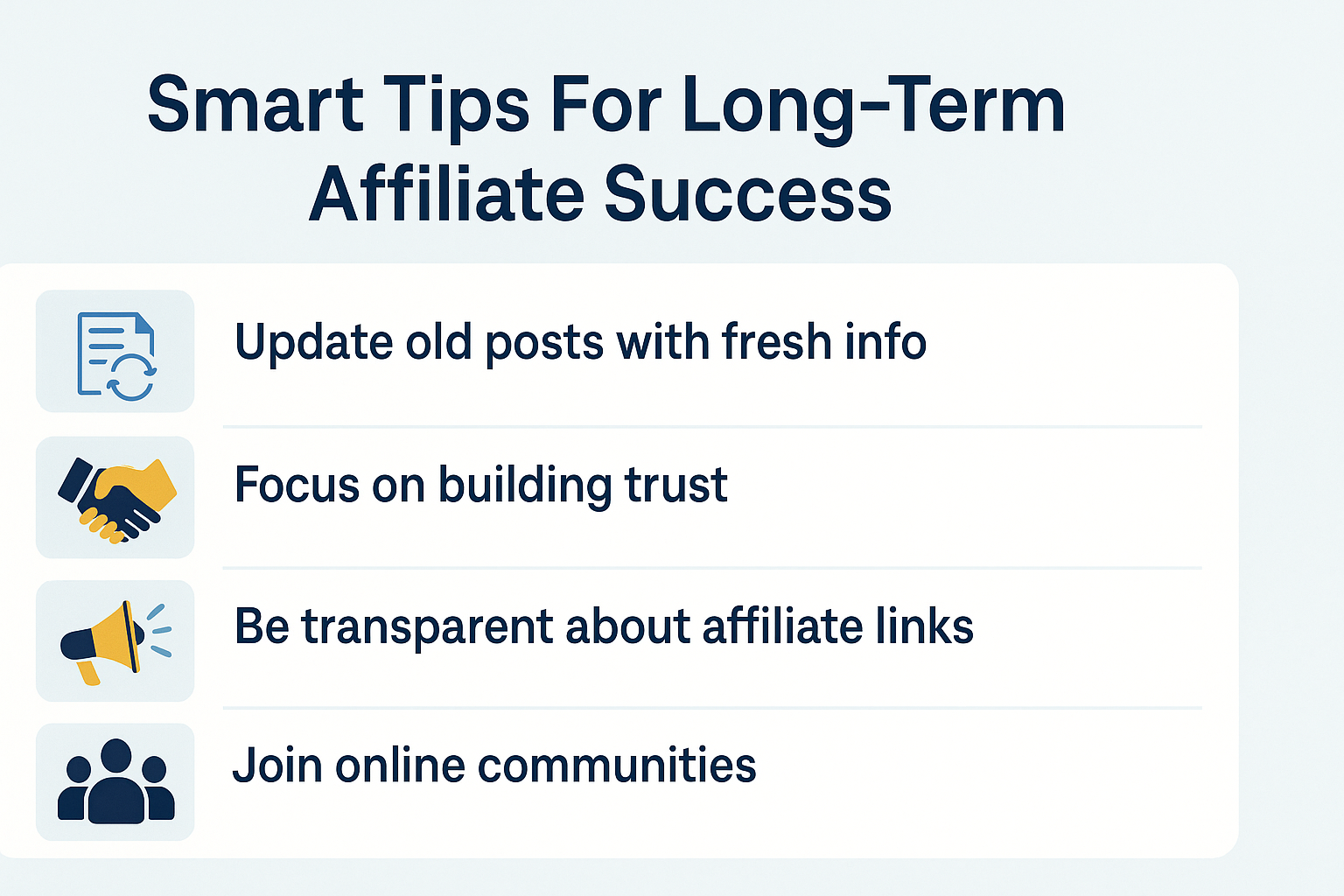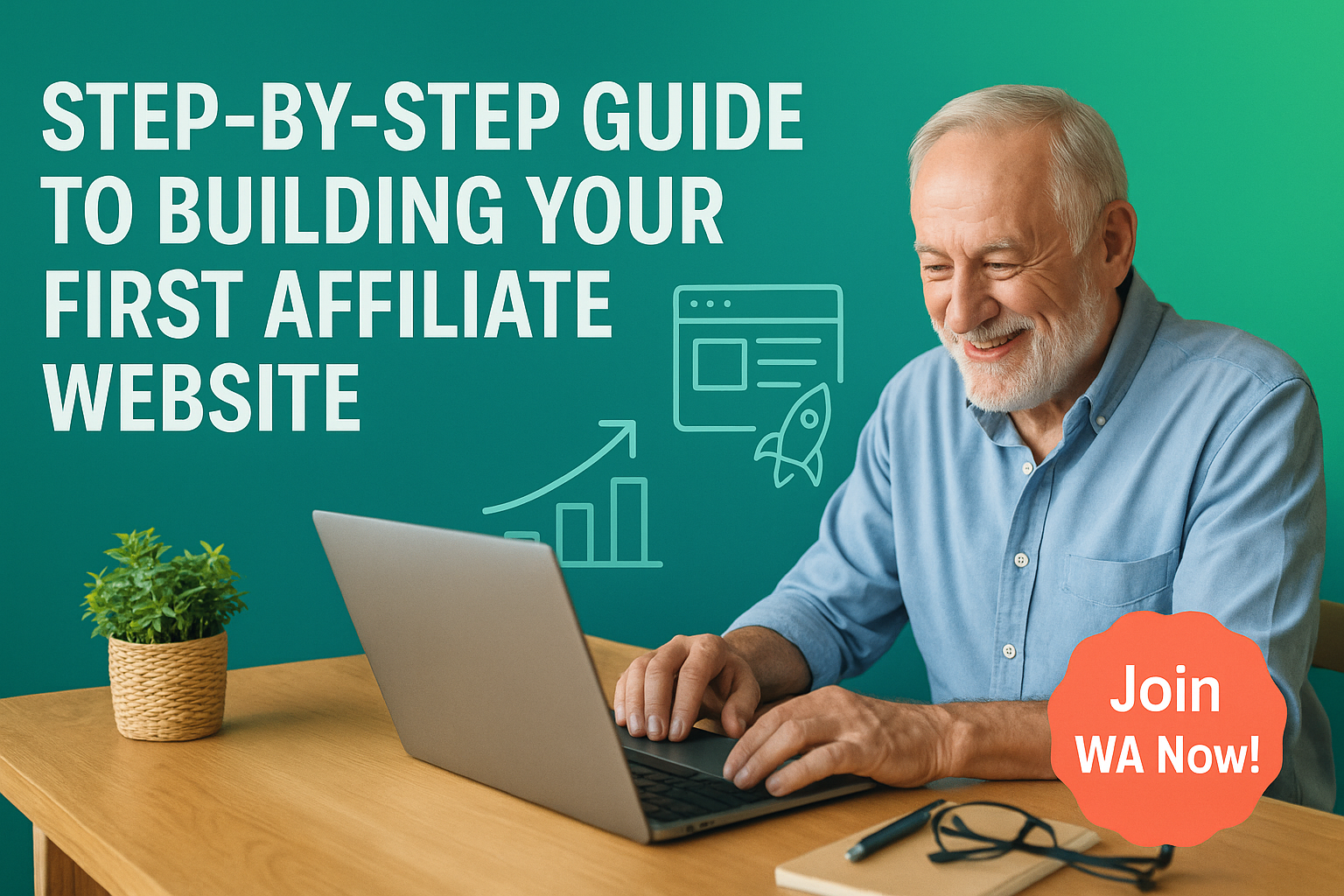Getting your first affiliate website up and running is exciting. Affiliate marketing gives you a shot at earning commissions by recommending products you genuinely find useful or interesting. Even if you’re brand new to websites or online marketing, you can build a solid foundation without too much hassle. Here’s the step-by-step guide I use myself (and share with friends) whenever someone asks how to build their very first affiliate site.

Why Affiliate Websites Make Sense for Beginners
Affiliate marketing has gained a lot of attention for good reason. It’s pretty affordable to start, doesn’t require any stock or shipping, and gives you tons of flexibility to work at your own pace. The idea is simple: you promote products through unique links, and if people purchase after clicking your link, you earn a commission. This setup is especially beginnerfriendly because you’re building on the authority and product pages of big brands or marketplaces like Amazon, ShareASale, or Commission Junction.
According to a recent report by Statista, spending on affiliate marketing in the United States alone is estimated to reach $8.2 billion by 2022. A lot of people are jumping in, and many manage to see $50, $100, or more a day once things are dialed in, even without prior experience.
With the basics covered, I’m jumping straight in so you can get started with real-world steps that work for beginners. Affiliate websites make good sense for anyone just getting started—there are plenty of low-cost entry points, flexible hours, and the chance to learn hands-on skills that help you in the long run. Building a site from scratch and steadily improving it is also a great confidence booster.
Picking Your Niche
A niche is the topic or industry your site will focus on. The right niche makes a huge difference. Choose something with enough products to promote, steady demand, and some affiliate programs available. If you go too broad, like “health and wellness,” you’ll compete with giant sites. Too narrow and you’ll run out of stuff to write about or promote.

Here’s what helps me decide on a good niche every time:
- Passion & Interest: Building a site takes work, so it’s easier if you pick something you’re genuinely interested in or want to learn more about.
- Profitability: Check if there are products and active affiliate programs already out there (use sites like Amazon Associates, Impact, or even just Google “your niche + affiliate program”).
- Competition: Competition isn’t all bad, but if the top results are huge, established sites, it’ll take harder work to get noticed. Using tools like Ubersuggest or just searching Google for a few key terms helps you see what’s out there.
Start your research here, jot down ideas, and narrow them by asking yourself if you’d be happy creating content on this topic for months at a time. Sometimes it helps to check out online forums or Facebook groups dedicated to different interests and spot what questions and topics keep coming up again and again. That way, you can easily match your ideas to actual demand and get a sense of realistic earning potential.
Setting Up Your Website (The Basics You Need)
Once you have a niche, it’s time to actually set up your site. Don’t stress about being a tech wizard; there are loads of tools out there that make this part easier than it sounds.
- Domain Name: Pick a name that hints at your niche (for example: “BestMountainGear.com”) and check availability on a site like Namecheap or GoDaddy. Domains usually cost around $10–$15 per year.
- Hosting: This is where your site ‘lives’ online. Beginnerfriendly options include Bluehost, SiteGround, or Hostinger. Expect to pay $3–$6 per month to start. Look for hosts with reliable uptime and good support.
- Website Platform: WordPress is the go-to for most affiliate marketers, thanks to flexibility and tons of free tutorials. Your hosting provider often offers oneclick WordPress installation.
- NicetoHave Extras: An SSL certificate (for secure browsing), and a simple, mobilefriendly theme (Astra, Kadence, or GeneratePress are all solid free options).
For most beginners, the total upfront investment usually ranges from $40 to $100 to get started, depending on the hosting you pick and any extras you add. Pretty reasonable, given the earning potential. If you want, you can start with just the basics—domain, hosting, WordPress, and a free theme—then add extras later as your site grows.
There are lots of free resources online to help you at every step, so don’t worry about getting stuck. If in doubt, ask in beginnerfriendly affiliate forums and you’ll find plenty of step-by-step videos or community guides to smooth the way.
Building Out Your Site: The Key Pages
With your site live, it’s time to add some content. You only need a handful of pages to get rolling, and the rest can follow as you grow. Here’s what I usually start with:
- Homepage: Briefly introduce your topic and how you help visitors. I keep this simple. Think quick welcome message plus links to your best content.
- About Page: Share a bit about yourself and why you built the site. Even a short personal story helps build trust.
- Contact Page: Let visitors reach you. Use a contact form plugin like WPForms if you’re on WordPress.
- Blog or Reviews Section: This is where you publish articles, reviews, or guides. Each article should help your target audience learn, solve a problem, or decide on what to buy.
Most affiliate sites grow from these basics by adding regular posts and reviews. Focus on helping people answer questions specific to your niche, like “Best hiking boots for beginners” or “How to clean a French press.” As your site gets more content, Google will start to pick up on your authority in the space. That’s when things can really start to snowball.
To take your first impression up a notch, add a simple privacy policy and affiliate disclosure page. Most affiliate networks require this, so including these right from the start can make approval to affiliate programs much smoother.
How To Apply and Set Up Affiliate Programs
Now comes the fun part: joining affiliate programs. Start by making a list of products and brands in your niche. Next, search the official website for “Affiliates” or use Google (brand name + affiliate program). Most programs are free to join. Some general networks like Amazon Associates, ShareASale, or CJ Affiliate let you apply for many different brands from one dashboard.
After you’re accepted, you’ll get access to links or banners you can add to your site. WordPress plugins like ThirstyAffiliates or Pretty Links make it easy to organize and manage your affiliate links and make them look tidy. Don’t forget, sometimes affiliate programs ask for your website before approval—having those basic pages in place shows you’re serious and can work in your favor.
As you grow, you can join additional or higher paying affiliate programs, but starting out with a few staple networks is the quickest way to get in the game. Over time, track your results to see which products convert best and double down on those relationships. Building trust with your audience means more clicks, more sales, and, eventually, new partnership opportunities with brands eager to work with you.
Content That Drives Traffic (and Sales)
Quality content is everything. Search engines and readers love wellorganized, useful posts that answer real questions. Here’s what I focus on with every new affiliate site:
- Product Reviews: Honest, detailed experiences with products you’ve used or researched. Include pros, cons, who the product is right for, and a straightforward verdict.
- Comparison Posts: Articles that compare a few different products, for example, “Bluehost vs. SiteGround: Which Is Better for Beginners?”
- How-To Guides: Walk people through solving a specific issue or learning a new skill, and naturally mention helpful products within these guides.
- Listicles: Example: “7 Best Coffee Makers for Busy Students.” Link out to each product using your affiliate links.
Write your content in a friendly, easy to understand way. Use headings, bullet points, and real examples or tips. This makes your information easier to digest and more relatable for beginners. Whenever possible, include photos, comparison tables, or even short videos to give your posts some nextlevel cool depth and catch a reader’s eye.
Don’t forget to use search-friendly titles that match what people actually type into Google. Tools like AnswerThePublic or even looking at the “People Also Ask” box in search results can help you brainstorm more specific post topics that are likely to bring in visitors.
Driving Targeted Traffic
Without visitors, your site can’t earn commissions. Most beginners start with SEO (search engine optimization), which means tailoring content so search engines show your posts to people searching for related topics. Basic plugins like Yoast SEO or Rank Math help you tick all the right boxes in WordPress.
You can also try pinning your articles on Pinterest, sharing them in niche Facebook groups, or answering questions in places like Quora to get some initial visits. Free traffic is nice, but eventually, some people explore paid ads or influencer partnerships to get things moving even faster. Over time, as your site builds momentum and content, you may even find other bloggers reaching out for guest post collaborations or link swaps—these can set your growth on fire if done right.
Experiment with a couple of these methods and focus on what seems to bring visitors in most easily. Don’t feel pressured to do everything at once. Instead, stick with one or two channels and get good at them before mixing in some variety.
Common Questions From Beginners
Starting out with affiliate marketing leaves a lot of folks wondering about costs, earnings, and the steps involved. Here are a few questions I get asked all the time:
How much does it cost to build an affiliate website?
Most beginners can launch their first site for $40–$100 covering the domain and hosting for a year. Any paid WordPress themes or plugins are optional. If you decide to invest more later, you can pick up premium tools or services as your income grows.
Can you make $100 a day with affiliate marketing?
It’s possible, but it doesn’t usually happen in the first week or month. Most people start out earning a few dollars here and there. As your content grows and your rankings improve, seeing $50–$100 per day starts to feel realistic, especially if you stick to it and keep learning. The key is to remain patient and keep adding value to your audience.
How do beginners start as affiliates?
Pick a niche, set up a simple website, join a few beginnerfriendly affiliate programs (like Amazon or eBay), and start publishing helpful content. You don’t need tons of cash up front—just steady effort and a willingness to learn as you go. Networking with others in online communities can also lead to new tips and faster progress.
How do I know what kind of content to publish?
Look at questions people ask in your niche (check Reddit, Quora, product reviews, or the “People Also Ask” section of Google). Write in-depth posts that genuinely help people make buying decisions or learn new things. You can also check competing affiliate sites in your niche and see what’s getting the most comments or social shares—that’s a good hint about what’s working.
How long does it take to get traffic?
Most new sites start seeing their first visitors after a month or two. SEO and consistent posting make a big difference, so try to put out fresh content weekly for the best shot at early traffic. If you use social media from day one, you might get a few visits even faster.
Smart Tips For Long-Term Affiliate Success

Growth takes time and a bit of patience. The affiliates who stick with it are the ones who keep learning, test new content ideas, and genuinely try to help their readers solve problems. Here’s a quick list of habits I find really helpful:
- Update old posts with fresh info or new products once in a while
- Read successful affiliate blogs to learn what’s working for others
- Focus on building trust—only promote stuff you’d recommend to a friend
- Be transparent about affiliate links (a simple disclaimer at the start of each post is enough and builds trust)
- Join online communities or masterminds for affiliates to share new insights and get feedback on your progress
Consistency adds up. Publishing content regularly and serving your readers’ needs is usually what turns a simple website into a real income stream. Always pay attention to reader feedback—whether through comments, emails, or social shares, staying sharp and making regular improvements is the secret sauce to steady growth. Over time, your authority in your niche will grow and you’ll be able to step up both your content and income potential.
Your Affiliate Website: Next Steps
Getting started with your first affiliate website doesn’t need to be complicated or expensive. It’s all about picking a focused niche, setting up a simple site, producing helpful content, and partnering with brands you feel good about recommending. As you put in the work, you’ll learn tricks and shortcuts that fit your style—and you could be well on your way to earning your first commissions sooner than you expect.
If you’re tossing around niche ideas or want to learn from others building their first sites, forums like Reddit’s r/affiliatemarketing or the Affiliate Fix community are packed with real-world advice and shared experiences. Starting is the biggest step. Everything else, you can learn along the way. The bottom line: put in honest effort, be willing to learn, and before long you’ll likely look back and be glad you took the plunge into affiliate marketing.

This is hands down one of the most practical and beginner-friendly guides I’ve seen on starting an affiliate website. It’s easy to get overwhelmed when diving into affiliate marketing for the first time, but the way you broke everything down—from picking a niche to getting that first bit of traffic—makes it feel totally doable.
I especially appreciated the reminders about long-term success: updating content, building trust, and staying transparent with affiliate links. It’s not just about quick wins—it’s about creating something valuable and sustainable. Great job, Gila! Definitely bookmarking this to share with a few people who keep asking me how to get started the right way.
Thank you so much, Jason! I’m really glad the guide resonated with you—it means a lot coming from someone who clearly understands the challenges of getting started. You’re absolutely right: long-term success in affiliate marketing comes down to trust, value, and consistency, not just chasing quick wins. I appreciate you bookmarking it and sharing it with others—that’s the biggest compliment I could ask for. Wishing you continued success, and feel free to drop by anytime with questions or tips of your own!
All the best
Gila
Great guide! I love how you break down each step clearly—it really helps take the overwhelm out of starting an affiliate site. The focus on picking a niche you enjoy and building realistic income goals is super encouraging.
I’m curious—have you noticed certain niches or strategies that help beginners earn their first commission faster?
Thanks so much, Kiersti! I’m really happy to hear the guide helped make things feel a bit less overwhelming—that was exactly my goal. ???? Picking a niche you genuinely enjoy makes such a big difference, especially when you’re in it for the long run.
As for getting that first commission faster, I’ve noticed that niches with clear buyer intent—like product comparisons or “best of” lists—can give beginners a quicker win. Also, focusing on solving specific problems for a defined audience (even a small one) tends to build trust faster. Happy to share more if you’re exploring ideas—just let me know!
All the best
Gila
I love the way you elaborated this opic. Affiliate marketing is a great way to start earning money online, especially if you’re broke. It’s cheap to get into, no need for stock or shipping, and you work on your own schedule. You promote products through links, and when someone buys, you earn a commission. Platforms like Amazon and ShareASale make it easy for beginners.
Spending on affiliate marketing is set to hit $8.2 billion in the U.S., so it’s clearly growing. Lots of people are making $50–$100 a day once they get the hang of it, even without prior experience.
It’s low-cost, flexible, and a great way to learn new skills. So, why not give it a shot?
Hi Linda,
Thank you so much for your thoughtful comment, and I apologize for the delayed response—I’ve been dealing with some health issues, but I’m back now! I’m so glad you found the article helpful. You’re absolutely right—affiliate marketing is an excellent option for those just starting out, especially since it has such low upfront costs and offers flexibility. No stock, no shipping, and the ability to work on your own schedule make it a fantastic opportunity for anyone looking to earn money online.
It’s also great to see that you pointed out the incredible growth in affiliate marketing, with spending on track to hit $8.2 billion in the U.S. It’s clear that this industry is only going to continue expanding, and many people are already seeing success, even without prior experience.
Thanks again for sharing your thoughts, Linda! I’m excited for anyone who decides to give affiliate marketing a shot—it really can be a game changer.
Best,
Gila
Thanks for laying it all out so clearly. I really appreciate how you broke the process down into manageable, confidence-building steps. It’s refreshing to see advice that doesn’t just hype up the potential earnings, but actually emphasizes the foundational work like niche research, honest reviews, and trust-building content.
One thing that stood out to me (and often gets glossed over in other posts) was your emphasis on realistic expectations like how $100/day won’t happen overnight, and why focusing on value and consistency is key.
As someone currently researching niches, I found your method of cross checking interest, profitability, and competition very helpful. I also took away some useful tips on wordpress plugins and webpage content and layout.
Have you found it more effective to start with product reviews or broader “how-to” content when launching a brand new site with no traffic yet? I am torn between writing helpful guides before doing product focused posts early on.
Also, I’d love to hear how often you revisit and update old content. I imagine that keeps older posts ranking well, but I’m curious if there’s a certain trigger (e.g., once per quarter, after traffic drops, etc.)
Again, thanks for sharing such a thoughtful, encouraging guide to staring in affiliate marketing!
Hi Saschi,
Thank you so much for your kind words and for taking the time to leave such a thoughtful comment. I truly apologize for the delayed response—I’ve been dealing with some health issues, but I’m back now and so glad to see your feedback!
I’m thrilled that you found the step-by-step guide helpful and that the focus on realistic expectations resonated with you. It’s so important to emphasize the hard work and consistency required, especially in the beginning when results can take time. I’m glad the niche research tips and WordPress suggestions were useful for you as well!
As for your question, I personally recommend starting with helpful “how-to” content first, especially for a brand-new site with no traffic. Establishing authority and providing value through educational content can help build trust and attract organic traffic. Once you’ve established that foundation, you can start incorporating product reviews, which will benefit from the trust and traffic you’ve built.
In terms of revisiting and updating old content, I usually make it a habit to revisit posts every 3–6 months. It’s a great way to ensure that your information stays current and relevant, which helps maintain or improve rankings. If I notice traffic starting to dip on a specific post or the content feels outdated, that’s usually my trigger to give it an update.
Thanks again for your thoughtful comment, Saschi! I’m so glad the guide helped, and I’m excited to hear about your progress as you move forward with affiliate marketing. If you have any more questions or need additional tips, feel free to reach out!
Best,
Gila